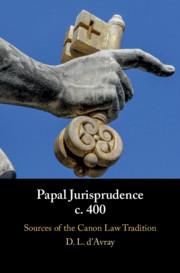Book contents
- Papal Jurisprudence c. 400
- Papal Jurisprudence c. 400
- Copyright page
- Dedication
- Contents
- Acknowledgements
- Abbreviations
- Manuscript Sigla
- 1 Introduction
- 2 The State of Research: Caspar and After
- 3 Texts and Manuscripts
- 4 Rituals and Liturgy
- 5 Status Hierarchy
- 6 Hierarchy of Authority
- 7 Celibacy
- 8 ‘Bigamy’
- 9 Marriage
- 10 Monks and the Secular Clergy
- 11 Heretics: Novatians, Bonosians, and Photinians
- 12 Heretics: In the Shadow of Augustine
- 13 Penance
- Epilogue
- Select Bibliography
- Index
10 - Monks and the Secular Clergy
Published online by Cambridge University Press: 13 December 2019
- Papal Jurisprudence c. 400
- Papal Jurisprudence c. 400
- Copyright page
- Dedication
- Contents
- Acknowledgements
- Abbreviations
- Manuscript Sigla
- 1 Introduction
- 2 The State of Research: Caspar and After
- 3 Texts and Manuscripts
- 4 Rituals and Liturgy
- 5 Status Hierarchy
- 6 Hierarchy of Authority
- 7 Celibacy
- 8 ‘Bigamy’
- 9 Marriage
- 10 Monks and the Secular Clergy
- 11 Heretics: Novatians, Bonosians, and Photinians
- 12 Heretics: In the Shadow of Augustine
- 13 Penance
- Epilogue
- Select Bibliography
- Index
Summary
The celibacy within marriage of the secular clergy may have been a response to the celibacy of monks, because monks were becoming prominent in Western Christianity in the fourth century. Originally lay, without clerical orders, their relation to the ordinary clergy, while not hostile, was complicated and problematic from the start. What happened when clerics became monks or vice versa, for instance? Dealing with the interactions of these two elites would be a central role of the papacy ever afterwards. In the early papal legislation we see the start of this mediating role.
- Type
- Chapter
- Information
- Papal Jurisprudence c. 400Sources of the Canon Law Tradition, pp. 180 - 189Publisher: Cambridge University PressPrint publication year: 2019

